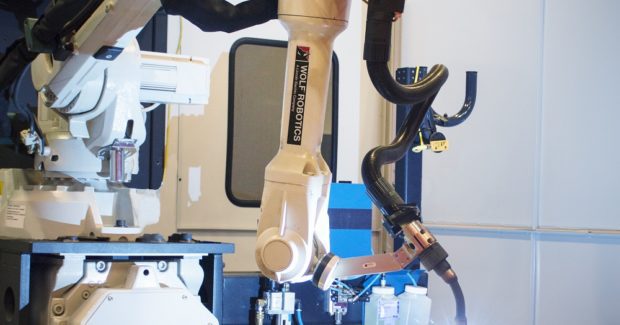Robotic Big Area Additive Manufacturing
The R-BAAM cell from Wolf Robotics is ideal for producing titanium aerospace parts and low volume, complex parts that can replace traditional, high cost, design-constrained castings in the steel casting sector.
Posted: February 20, 2017
Wolf Robotics, LLC (Fort Collins, CO), a Lincoln Electric Company (Cleveland OH), is paving the road for advancements in Robotic Big Area Additive Manufacturing (R-BAAM) with arc-based steel additives using Power Wave® Surface Tension Transfer® (STT®) that helps move metal additive manufacturing out of the traditional small-area, bed-built processes and dramatically expands build envelopes for robotically printing metal parts. Cultivated as a result of an industry need, Wolf developed this innovative, multi-meter build envelope, multi-feedstock and multi-material robotic additive system. As the first of its kind, the system features both a laser powder and a laser hot-wire process for steel and titanium materials. It is ideal for producing titanium aerospace parts and low volume, complex parts that can replace traditional, high cost, design-constrained castings in the steel casting sector.
“This Robotic Big Area Additive Manufacturing equipment is not too unlike traditional cladding efforts,” explained Jason Flamm, a product manager at Wolf Robotics. “Instead of simply adding material from a melted wire, however, this new system relies on a laser powder and a laser hot-wire process to create the layers of steel and titanium that turn into aerospace parts. We think this is a perfect alternative to traditional steel castings used to create complex parts.” Flamm said this robotic approach is much more cost-effective because it uses technology that most metal fabricators are familiar with. “It’s a simple matter of ‘CAD to toolpath,’” he added, referring to the automated programming of the robot. “This has the advantage of well-established and tried-and-true GMAW equipment and robotic equipment being powered with easy-to-use software. That is what makes this cell attractive.”
Wolf Robotics, LLC, 4600 Innovation Drive, Fort Collins, CO 80525, 970-225-7600, Fax: 970-225-7700, www.wolfrobotics.com, www.lincolnelectric.com.















